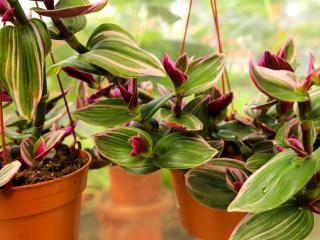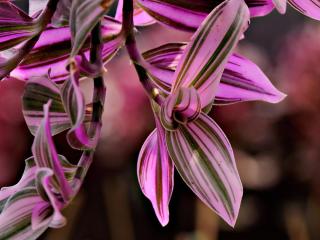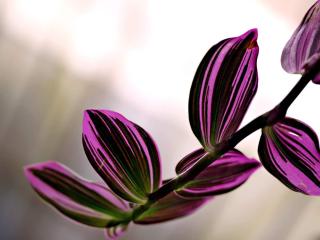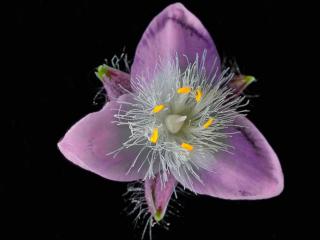

Tradescantia Nanouk: a magnificent plant with shades of green and pink foliage.
Key Tradescantia Nanouk facts
Name: Tradescantia albiflora ‘Nanouk’
Family: Commelinaceae
Type: perennial plant
Shape: upright, compact
Height: 8 inches to 3 feet (20 cm to 1 m)
Exposure: bright (no direct sun)
Watering: consistent and moderate
Repotting: spring
Foliage: evergreen – Blooming: summer (tiny flowers, though)
It’s particularly easy to grow and care for, and propagates successfully from cuttings.

This grass-related plant doesn’t like the cold: keep it away from temperatures below 41°F (below 5°C).
To get even more lively-colored leaves, T. Nanouk needs a lot of natural light. In low light, you might end up with regular, duller-looking leaves. But in all cases, try to avoid direct, harsh afternoon sun: it’s likely to burn the leaves and dry them out from the edges.
→ See it growing on an indoor plant wall.
Tradescantia roots well in draining soil mix. Mix up garden soil with coarse sand, compost, or manure, nothing more is needed.
→ Warning: Tradescantia sap contains harmful chemicals. Skin gets irritated when touched. Gastro issues when ingested. Keep pets and toddlers away.

Similarly, over-fertilizing might cause leaf tip burns. Every 6 to 8 weeks, treat your tradescantia to some diluted liquid fertilizer – just make sure it’s half-strength.
For a fuller plant, pinch longer stems now and then. Don’t hesitate to trim stems that spread out too much.
Repot your Tradescantia albiflora ‘Nanouk’ in spring if it starts outgrowing its pot and threatens to tip it over.

You can also root your cuttings in water, provided it’s chlorine-free and the cutting enjoys bright, indirect light. Once roots emerge, plant it in soil or let it thrive in water.
Over-watering can lead to fungal infections and tradescantia root rot. So, never let soil get too soggy. Conversely, a dry plant becomes a magnet for spider mites.
Common Name: Tradescantia nanouk, Fantasy Venice, Wandering Jew, Dayflower
Origin: North and South America
Tradescantia albiflora ‘Nanouk’ boasts a compact perennial form. It stands proud at first, but eventually cascades to all sides and overflows from its pot.
The ‘Nanouk’ gives a striking impression at first glance, with thick stems and leathery, broad, lance-shaped leaves that curve slightly. These leaves are dressed in gray-green with light pink and cream-white stripes. Flip them over, and you’ll see shades of pink and violet.

The Tradescantia genus spans 75 perennial varieties native to the Americas. T. ‘Nanouk’ is a new variety, born in the Netherlands in 2012 from the cross-breeding of two Tradescantia albiflora species.